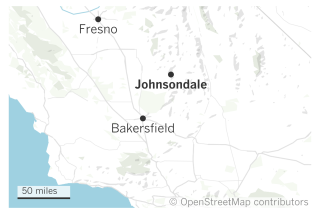Saving Other Children
- Share via
Kim Patrick’s son was 2 when he wandered off and fell into a swimming pool. He was in a coma for 10 days before he finally died. Three years later, the memory still stings.
Now a drowning-prevention specialist with the Anaheim Fire Department, the 38-year-old Lakewood resident knows she is not alone in her pain. This year, in fact, she has too much company.
So far this year, seven children 5 and younger have drowned in Orange County, all but one in swimming pools. That’s more than all of the pool and bathtub drownings last year, and--with the warm months ahead--the number of drownings is already approaching the 10-year average of eight a year.
The drownings have cut across the county: A 4-year-old boy in Huntington Beach, a 23-month-old girl in Yorba Linda, a 2-year-old boy in Orange. The latest victim was 2-year-old Chance Beidleman who fell into the family’s Huntington Beach pool Wednesday and died the next day.
“I’m extremely worried because the statistics are up before ‘drowning season’ has even started,” said Patrick, referring to the summer months when backyard pools and spas become favorite destinations.
Drowning is one of the nation’s leading causes of death among children 5 and younger and the top cause in Orange County, according to the Orange County Fire Authority. Indeed, in Southern California, where pools are abundant and the weather is inviting, preschool-age drownings are a year-round concern. Still, the early rise in the numbers has health and fire officials frustrated because they have worked for years to educate residents on swimming pool safety.
Health and fire officials say lack of parental care, distractions and sometimes outright disregard for a child’s safety are all factors in preschool-age drownings.
Over the years, experts have gone to schools, distributed pamphlets to parents, held classes and urged residents to build fences around their pools. Health officials in Orange County meet monthly during the summer and every other month the rest of the year, working on ways to teach pool safety. Officials at Children’s Hospital of Orange County have begun distributing a Spanish-language video about pool safety and have developed a multimedia CD that includes the same basic lessons.
Authorities also, for the first time, are keeping track of near-drownings in an effort to gather more data on the circumstances of pool accidents.
The effectiveness of the educational efforts over the years is hard to gauge, experts agree. Statistics shows few patterns in child drownings in pools. The numbers fluctuate, running as high as 15 in 1993 and then dropping to as few as four last year. Authorities agree that seven deaths before summer is disturbingly high.
In addition to the higher number this year, authorities expressed concern that a summer filled with blackouts could draw even more people to pools or result in residents leaving doors open when air conditioners shut off.
“This year could be very bad,” said Dr. Mike Ritter, an emergency room doctor at Mission Hospital Regional Medical Center in Mission Viejo who lectures on drowning prevention.
“When people aren’t running their air conditioners, they’ll be out at their pools,” Ritter said. “That just increases the chances of drowning. All it takes is a few seconds when you look away: You don’t hear them when they go under.”
According to a 1986 study, the last major examination by the U.S. Consumer Product Safety Commission, almost 70% of the children who drown in pools or spas are last seen in their homes, not next to a pool.
“If I am worried about the energy crisis it is that people will leave their glass doors open, or their back doors open, and the child will find their own way to the pool. It just takes one small slip,” said Marcia Kerr, a spokeswoman for the safety commission whose own son died when he fell into the family’s backyard pool that had been left uncovered.
After child drownings and near-drownings reached a disturbing level in the late 1980s, authorities in Phoenix adopted what they say is the nation’s most restrictive law on fencing off pools. The law, adopted in 1991, makes it mandatory for all homes--old or new--to have fences around pools and spas. The year after the law went into effect, according to the Phoenix Fire Department statistics, the number of drownings and near-drownings dropped dramatically from 75 in 1991 to 32 the following year.
California’s law is less restrictive, though all new pools must be set off by fences or a barrier. While fences offer a good first line of defense, officials say paying close attention to the whereabouts of children is the best protection.
Kerr lost her son, Cody, in 1988 and still calls herself “stupid.” She said she lives every day with guilt. Pool workers had cleaned the pool the day Cody died, and Kerr and her husband, Bill, had told them to leave the cover off. The child slipped away and fell into the pool while his nanny was making sandwiches. He was found a short time later floating in the shallow end.
“I’m not sure what the answer is to why the numbers are higher right now,” she said. “Maybe there isn’t one, but people should be aware of the effects. It stays with you forever.”
Ritter said the most devastating thing he sees is when a young drowning victim arrives at his hospital and he watches the parents come apart.
“The worst thing about a child drowning is that almost all of the time the parents were right there, they saw it. They only blinked or looked away for a second, but they witnessed it. That just [amplifies] just how preventable the problem is.”
That’s what got Patrick and her husband involved. She joined the Anaheim Fire Department as a specialist in pool safety and her husband, Michael, started a business installing pool barriers.
The Patricks have a second child now, an 11-month-old daughter. They say having another child has sustained their marriage and affirmed their will to teach others about pool safety. “Brandon will always be with us,” she said. “The pain will always be with us. . . . But we have another chance now.”
More to Read
Sign up for Essential California
The most important California stories and recommendations in your inbox every morning.
You may occasionally receive promotional content from the Los Angeles Times.













